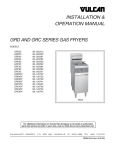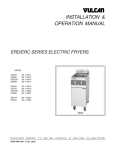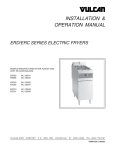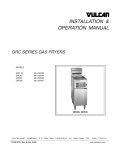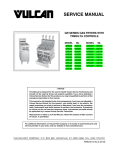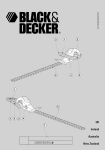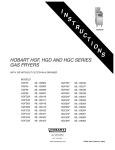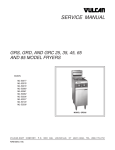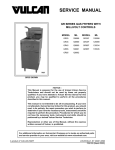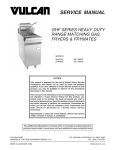Download Vulcan-Hart GRS65 Specifications
Transcript
INSTALLATION & OPERATION MANUAL GR SERIES GAS FRYERS MODELS: GRS25 GRS35 GRS45 GRS65 GRS85 GRD25 GRD35 GRD45 GRD65 GRD85 GRD35 VULCAN-HART COMPANY, FORM 30748, Rev. B (1-98) P.O. BOX 696, LOUISVILLE, KY 40201-0696, GRS65 TEL. (502) 7 7 8 - 2 7 9 1 IMPORTANT SAFETY INFORMATION THIS MANUAL HAS BEEN PREPARED FOR PERSONNEL QUALIFIED TO INSTALL GAS EQUIPMENT, WHO SHOULD PERFORM THE INITIAL FIELD START-UP AND ADJUSTMENTS OF THE EQUIPMENT COVERED BY THIS MANUAL. POST IN A PROMINENT LOCATION THE INSTRUCTIONS TO BE FOLLOWED IN THE EVENT THE SMELL OF GAS IS DETECTED. THIS INFORMATION CAN BE OBTAINED FROM THE LOCAL GAS SUPPLIER. IMPORTANT IN THE EVENT A GAS ODOR IS DETECTED, SHUT DOWN UNITS AT MAIN SHUT-OFF VALVE AND CONTACT THE LOCAL GAS COMPANY OR GAS SUPPLIER FOR SERVICE. FOR YOUR SAFETY DO NOT STORE OR USE GASOLINE OR OTHER FLAMMABLE VAPORS OR LIQUIDS IN THE VICINITY OF THIS OR ANY OTHER APPLIANCE. IN THE EVENT OF A POWER FAILURE, DO NOT ATTEMPT TO OPERATE THIS DEVICE. WARNING: IMPROPER INSTALLATION, ADJUSTMENT, ALTERATION, SERVICE OR MAINTENANCE CAN CAUSE PROPERTY DAMAGE, INJURY OR DEATH. READ THE INSTALLATION, OPERATING, AND MAINTENANCE INSTRUCTIONS THOROUGHLY BEFORE INSTALLING OR SERVICING THIS EQUIPMENT. 2 TABLE OF CONTENTS GENERAL. . . . . . . . . . . . . . . . . . . . . . . . . . . . . . . . . . . . . . . . . . . . . . . . . . . . . . . . . . . . . . . . . . . . . . . . GR Series Gas Fryers . . . . . . . . . . . . . . . . . . . . . . . . . . . . . . . . . . . . . . . . . . . . . . . . . . . . . . . Finish Options . . . . . . . . . . . . . . . . . . . . . . . . . . . . . . . . . . . . . . . . . . . . . . . . . . . . . . . . . Features, Construction Features, Battery Configurations . . . . . . . . . . . . . . . . . . . . . . . Field Installable Accessories, Factory Installed Only . . . . . . . . . . . . . . . . . . . . . . . . . . GR Series Frymate (Dump Station) . . . . . . . . . . . . . . . . . . . . . . . . . . . . . . . . . . . . . . . . . . . . . Finish Options, Features . . . . . . . . . . . . . . . . . . . . . . . . . . . . . . . . . . . . . . . . . . . . . . . . . 4 4 4 5 6 6 6 INSTALLATION . . . . . . . . . . . . . . . . . . . . . . . . . . . . . . . . . . . . . . . . . . . . . . . . . . . . . . . . . . . . . . . . . . . Uncrating . . . . . . . . . . . . . . . . . . . . . . . . . . . . . . . . . . . . . . . . . . . . . . . . . . . . . . . . . . . . . . . . . . Location . . . . . . . . . . . . . . . . . . . . . . . . . . . . . . . . . . . . . . . . . . . . . . . . . . . . . . . . . . . . . . . . . . . Installation Codes and Standards . . . . . . . . . . . . . . . . . . . . . . . . . . . . . . . . . . . . . . . . . . . . . . Assembly . . . . . . . . . . . . . . . . . . . . . . . . . . . . . . . . . . . . . . . . . . . . . . . . . . . . . . . . . . . . . . . . . . Legs . . . . . . . . . . . . . . . . . . . . . . . . . . . . . . . . . . . . . . . . . . . . . . . . . . . . . . . . . . . . . . . . . Casters (Optional) . . . . . . . . . . . . . . . . . . . . . . . . . . . . . . . . . . . . . . . . . . . . . . . . . . . . . . Gas Connections . . . . . . . . . . . . . . . . . . . . . . . . . . . . . . . . . . . . . . . . . . . . . . . . . . . . . . . . . . . Gas Pressures and Orifices . . . . . . . . . . . . . . . . . . . . . . . . . . . . . . . . . . . . . . . . . . . . . . . . . . . Testing the Gas Supply Piping System . . . . . . . . . . . . . . . . . . . . . . . . . . . . . . . . . . . . . . . . . . Leveling the Fryer . . . . . . . . . . . . . . . . . . . . . . . . . . . . . . . . . . . . . . . . . . . . . . . . . . . . . . . . . . . Flue Connections . . . . . . . . . . . . . . . . . . . . . . . . . . . . . . . . . . . . . . . . . . . . . . . . . . . . . . . . . . . Electrical Connections . . . . . . . . . . . . . . . . . . . . . . . . . . . . . . . . . . . . . . . . . . . . . . . . . . . . . . . 7 7 7 7 7 7 7 8 8 8 8 8 8 OPERATION . . . . . . . . . . . . . . . . . . . . . . . . . . . . . . . . . . . . . . . . . . . . . . . . . . . . . . . . . . . . . . . . . . . . . 9 Before First Use . . . . . . . . . . . . . . . . . . . . . . . . . . . . . . . . . . . . . . . . . . . . . . . . . . . . . . . . . . . . 9 Lighting the Manual Gas Pilot . . . . . . . . . . . . . . . . . . . . . . . . . . . . . . . . . . . . . . . . . . . . . . . . . 9 Filling the Fry Tank with Shortening . . . . . . . . . . . . . . . . . . . . . . . . . . . . . . . . . . . . . . . . . . . . 9 Controls . . . . . . . . . . . . . . . . . . . . . . . . . . . . . . . . . . . . . . . . . . . . . . . . . . . . . . . . . . . . . . . . . . 10 Melting Solid Shortening . . . . . . . . . . . . . . . . . . . . . . . . . . . . . . . . . . . . . . . . . . . . . . . . . . . . 11 Turning the Fryer On . . . . . . . . . . . . . . . . . . . . . . . . . . . . . . . . . . . . . . . . . . . . . . . . . . . . . . . 11 Turning the Fryer Off . . . . . . . . . . . . . . . . . . . . . . . . . . . . . . . . . . . . . . . . . . . . . . . . . . . . . . . 11 Electronic Igniter (Optional) . . . . . . . . . . . . . . . . . . . . . . . . . . . . . . . . . . . . . . . . . . . . . . . . . . 11 Frying (All Models) . . . . . . . . . . . . . . . . . . . . . . . . . . . . . . . . . . . . . . . . . . . . . . . . . . . . . . . . . 12 Daily (All Models) . . . . . . . . . . . . . . . . . . . . . . . . . . . . . . . . . . . . . . . . . . . . . . . . . . . . . . . . . . 12 Daily Filtering . . . . . . . . . . . . . . . . . . . . . . . . . . . . . . . . . . . . . . . . . . . . . . . . . . . . . . . . . . . . . 12 Fryers Without Filter Ready Options . . . . . . . . . . . . . . . . . . . . . . . . . . . . . . . . . . . . . . 12 Filtering Procedure (Not Filter Ready) . . . . . . . . . . . . . . . . . . . . . . . . . . . . . . . . . . . . . 13 Filter-Ready Fryers Only . . . . . . . . . . . . . . . . . . . . . . . . . . . . . . . . . . . . . . . . . . . . . . . . 13 Battery Interplumbing (Optional) . . . . . . . . . . . . . . . . . . . . . . . . . . . . . . . . . . . . . . . . . . 13 Shortening Life (All Models) . . . . . . . . . . . . . . . . . . . . . . . . . . . . . . . . . . . . . . . . . . . . . . . . . . 13 High Limit Device (All Models) . . . . . . . . . . . . . . . . . . . . . . . . . . . . . . . . . . . . . . . . . . . . . . . . 13 Cleaning (All Models) . . . . . . . . . . . . . . . . . . . . . . . . . . . . . . . . . . . . . . . . . . . . . . . . . . . . . . . 14 MAINTENANCE . . . . . . . . . . . . . . . . . . . . . . . . . . . . . . . . . . . . . . . . . . . . . . . . . . . . . . . . . . . . . . . . . . Lubrication . . . . . . . . . . . . . . . . . . . . . . . . . . . . . . . . . . . . . . . . . . . . . . . . . . . . . . . . . . . . . . . . Vent . . . . . . . . . . . . . . . . . . . . . . . . . . . . . . . . . . . . . . . . . . . . . . . . . . . . . . . . . . . . . . . . . . . . Service and Parts Information . . . . . . . . . . . . . . . . . . . . . . . . . . . . . . . . . . . . . . . . . . . . . . . . 3 15 15 15 15 INSTALLATION AND OPERATION MANUAL FOR GR SERIES GAS FRYERS KEEP THESE INSTRUCTIONS FOR FUTURE USE GENERAL Vulcan-Hart GR Series Gas Fryers are available in 5 sizes with an array of features and options for a range of commercial fryer applications. While the overall tank width on the GR35 and GR45 are the same, the GR45 has a deeper tank area than GR35. Thus the GR45 has larger tank capacity than GR35 but not as large as GR65. Likewise the GR65 and GR85 are the same width, but the GR85 with a deeper tank area has a larger tank capacity than the GR65. Each gas burner tube has 30,000 BTU input rating. Model No. Tubes BTU Input Width Lb. of Fry Compound GRS25, GRD25 2 60,000 101⁄2" 25-30 GRS35, GRD35 3 90,000 151⁄2" 35-40 GRS45, GRD45 4 120,000 151⁄2" 45-50 GRS65, GRD65 5 150,000 21" 65-70 GRS85, GRD85 5 150,000 21" 70-85 GR Series Fryers can be free standing (except for GRS25 and GRD25) or arranged in batteries of 2 to 5 units. The number preceding the model number of your GRS or GRD Series Fryer refers to the number of units in a battery. One unit in a battery can be a Frymate Dump Station (only one per battery). GRS Fryers have a mechanical thermostat and GRD Fryers have a solid state thermostat. GRC Fryers, while part of the GR Series, are covered in a separate manual. Feature options include Fat Melt (standard on GRD); Basket Lift(s) with Timer(s); Tri, Twin, or Single Baskets; Pilot or Electronic Igniter; Filter Ready (except GRS25 and GRD25); and Battery Interplumbing. Finish options include: S/S Sides and Flue; S/S Tank; and Casters. S/S Legs are standard. Your Vulcan Fryer is constructed and designed to give long satisfactory service, providing it is properly installed, adjusted and maintained. The Mobile Filter is covered under separate Installation and Operation Manual. GR Series Fryer — Finish Options All Models Front Door Standard Stainless Steel Optional Not Applicable Ext. Sides & Flue Tank Legs Painted Steel Carbon Steel Stainless Steel Legs Stainless Steel Stainless Steel Casters 4 GR Series Fryer — Features Model Pilot Igniter Electronic Fat Melt Cycle Thermostat Basket Lift(s) Basket(s) Twin Single Tri GRS25, GRS35, GRS45, GRS65, GRS85 Std. Opt. Opt. Mechanical Opt. N/A Std. Std. Std. Opt. Opt. N/A N/A Opt. GRD25, GRD35, GRD45, GRD65, GRD85 Std. Opt. Std. Solid State Opt. N/A Std. Std. Std. Opt. Opt. N/A N/A Opt. GR Series Fryer — Construction Features Model Filter Ready Battery Configuration Battery Interplumbing GRS25, GRD25 Mobile Filter Not Available Std. Opt. with GR35, GR45, GR65, GR85, R015 or R021 GRS35, GRD35 Opt. (Use MF50.) Opt. Opt. GRS45, GRD45 Opt. (Use MF50.) Opt. Opt. GRS65, GRD65 Opt. (Use MF85.) Opt. Opt. GRS85, GRD85 Opt. (Use MF85.) Opt. Opt. BATTERY CONFIGURATIONS Batteries of up to five units wide can be configured with any GR Series Fryer or Frymate Dump Station (either 151⁄2" or 21" wide). Possible configurations showing positions A through E are depicted below: A A B A B C A B C D A B C D E NOTES: = Dump Station; = Fryer. * Indicates filter interplumbing not available. A filter dump station can be located under any position in a battery if it has been built without an RO Frymate. A filter dump station can be located under any position in a battery if the line-up has been built with an RO Frymate located at either end of the battery. When an RO Frymate is built between two fryers within a battery, the filter dump station is located under the RO Frymate. In two-unit batteries utilizing an RO Frymate, the filter dump station will always be located under the fryer. The GRS25 and GRD25 Fryers are not available as stand alone fryers or with filter dump stations. They are available with filter interplumbing when batteried with GRS/GRD35, 45, 65 and 85 Fryers. All options and accessories can be used with batteried equipment. 5 Field Installable Accessories Factory Installed Only Casters Twin Baskets Single Baskets Tri Baskets (GR65/GR85 only) Heat Lamp Flex Hose 4' Flex Hose 5' S/S Vat Cover Batter Tray Tank Skimmer Tank Scoop Electronic Pilot Fat Melt Basket Lift S/S Tank S/S Sides Battery Configuration Battery Interplumbing GR SERIES FRYMATE (Dump Station) Model RO Frymate Dump Station can be configured in batteries with fryers in either 151⁄2" or 21" width. Frymate provides a final prep area where excess oil drains away and product is seasoned, packaged, and kept ready for sale. RO Series Frymate — Finish Options Model RO15, RO21, RO21S* Front Door Sides & Dummy Flue Legs Standard Optional Stainless Steel Painted Steel Stainless Steel Legs Not Applicable Stainless Steel Casters *Model RO15 is for use with all GR25, GR35 and GR45 Series Fryers. Model RO21 is for use with all GR65 Series Fryers. Model RO21S is for use with all GR85 Series Fryers. RO Series Frymate — Features Heat Lamp Opt. Tops Drain Solid Pan Solid Pan Perforated Std. Opt. Opt. Opt. * Side liners are not available in batteries with RO interplumbed Frymates. 6 Side Liners* Opt. INSTALLATION ASSEMBLY Before installing the fryer, verify that the type of gas (natural or propane) agrees with the specifications on the fryer data plate which is located on the inside of the door panel. Also be sure the unit is built for the installation elevation. The fryer must be restrained to prevent tipping when installed in order to avoid the splashing of hot liquid. The means of restraint may be the manner of installation, such as connection to a battery of appliances or installing the fryer in an alcove, or by separate means, such as adequate ties. UNCRATING This fryer was carefully inspected before leaving the factory. The transportation company assumes full responsibility for safe delivery upon acceptance of the shipment. Immediately after unpacking the fryer, check it for possible shipping damage. If the fryer is found to be damaged, save the packaging material and contact the carrier within 15 days of delivery. Legs Position fryer in an open space near the final installation area. Tilt fryer on its side, being careful to avoid scratching the finish. Thread legs into mounting holes provided on bottom of fryer by screwing in a clockwise rotation until tight. Do not use the door or its handle to lift or move the fryer. Carefully raise fryer to its normal position and place it in installing location. LOCATION Casters (Optional) The equipment area must be kept free and clear of combustible substances. It is recommended that casters be installed on all batteried appliances. Minimum clearance from combustible construction is 6" from the sides and 6" from the back of the fryer. Minimum clearance from non-combustible construction is 0" from the sides and 6" from the back of the fryer. There must be at least 16" clearance between the fryer and any open top flame units. Adequate clearances for servicing and proper operation must be allowed. The unit may be installed on combustible floors. If the fryer is equipped with casters the gas connector (available from Vulcan-Hart) must comply with the Standard for Connectors of Movable Gas Appliances, ANSI-Z21.69 (latest edition), and a quick-disconnect device that complies with the Standard for Quick-Disconnect Devices for Use With Gas Fuel, ANSI-Z21.41 (latest edition). Provide a gas line strain relief (Fig. 1) to limit movement of the fryer without depending on the connector and/or any quick-disconnect device or its associated piping to limit the appliance movement. Install the fryer in an area with sufficient air supply for combustion of the gas at the fryer burners. Provide adequate clearance for air openings into the combustion chamber. Do not obstruct the flow of combustion and ventilation air. If it is necessary to disconnect the restraint, turn off the gas supply before disconnection. Reconnect the restraint before turning the gas supply on and returning the unit to its installation position. Do not permit fans to blow directly at the fryer. Avoid open windows next to the unit sides or back. Avoid wall-type fans which create air cross currents within the room. Instructions for installing casters to the fryer are included with the casters. INSTALLATION CODES AND STANDARDS STRAIN RELIEF FITTING FOR GAS LINE THIS SIDE ONLY. (Strain relief fitting supplied by Vulcan-Hart. Chain to be supplied by others.) Vulcan-Hart fryers should be installed in accordance with state and local codes, or in the absence of local codes, with the National Fuel Gas Code, ANSI-Z223.1 (latest edition), available from American Gas Association, Inc., 1515 Wilson Boulevard, Arlington, VA 22209, and with ANSINFPA Standard #96, Vapor Removal from Cooking Equipment, (latest edition) available from the National Fire Protection Association, Batterymarch Park, Quincy, MA 02269. PL-51493 Fig. 1 7 GAS CONNECTIONS FLUE CONNECTIONS CAUTION: All gas supply connections and any pipe joint compound must be resistant to the action of propane gases. The fryer must be located under a hood which has an adequate connection to an exhaust duct. The hood must extend 6" beyond fryer sides. The gas inlet is located at the lower right rear. Codes require that a gas shutoff valve be installed in the gas line ahead of the fryer. Adequate ventilation must be provided and must comply with NFPA Standard #96, (latest edition), and with local codes. Clearance above fryer should be adequate for products of combustion to be removed efficiently. An 18" minimum clearance should be maintained between the flue vent and the filters of the hood venting system. The gas supply line must be at least the equivalent of 1 ⁄2" iron pipe. If using the optional quick-disconnect flex hose, 3⁄4" iron pipe must be used unless 3⁄4" to 1 ⁄2" reducing fittings are used. Make sure the pipes are clean and free of obstructions, dirt, and piping compound. A battery requires one or two connections of appropriate size and type for the gas requirement. Never make flue connections directly to the fryer. Do not obstruct the flow of the flue gases from the flue duct located at the rear of the appliance. WARNING: PRIOR TO LIGHTING, CHECK ALL JOINTS IN THE GAS SUPPLY LINE FOR LEAKS. USE SOAP AND WATER SOLUTION. DO NOT USE AN OPEN FLAME. Adequate air should be provided in the kitchen to replace air taken out by the ventilating system. This will prevent fryer function from being affected by a reduced atmospheric pressure. After piping has been checked for leaks, fully purge gas pipes to remove air. ELECTRICAL CONNECTIONS WARNING: ELECTRICAL AND GROUNDING CONNECTIONS MUST COMPLY WITH THE NATIONAL ELECTRICAL CODE, ANSI/NFPA 70 OR THE CANADIAN ELECTRICAL CODE, CSA C22.2 AND/OR OTHER LOCAL CODES. GAS PRESSURES AND ORIFICES The standard orifices are set at 4" W.C. (Water Column) pressure for natural gas and 10" W.C. (Water Column) pressure for propane gas. A pressure regulator is supplied as part of the gas control valve. When test pressures exceed 1⁄2 psig (3.45 kPa), the fryer and its individual shutoff valve must be disconnected from the gas supply piping system. WARNING: APPLIANCES EQUIPPED WITH ELECTRICAL SUPPLY CORD(S) ARE PROVIDED WITH A THREE-PRONG GROUNDING PLUG WHICH MUST BE CONNECTED TO A PROPERLY GROUNDED RECEPTACLE. IF THE RECEPTACLE IS NOT THE PROPER GROUNDING TYPE, CONTACT AN ELECTRICIAN. DO NOT REMOVE THE GROUNDING PRONG FROM THE PLUG. When test pressures are 1⁄2 psig (3.45 kPa) or less, the fryer must be isolated from the gas supply piping system by closing its individual shutoff valve. Some fryers (depending on options) are equipped with a 120 Volt/60 Hz./1 Phase cord and plug which requires only that it be plugged into a properly grounded 120 volt receptacle. LEVELING THE FRYER Do not connect fryer to electrical supply until after gas connections have been made. TESTING THE GAS SUPPLY PIPING SYSTEM Once gas connections have been made, place a spirit level on top of the fryer. Adjust the legs to ensure that the fryer is level front-to-back and side-to-side in the final installed position. 8 OPERATION WARNING: HOT OIL AND PARTS CAN CAUSE BURNS. USE CARE WHEN OPERATING, CLEANING AND SERVICING THE FRYER. WARNING: SPILLING HOT FRYING COMPOUND CAN CAUSE SEVERE BURNS. DO NOT MOVE FRYER WITHOUT DRAINING ALL FRYING COMPOUND FROM THE TANK. Fig. 3 BEFORE FIRST USE 5. Turn gas valve extension arm to the ON position. Clean the Fryer 6. Repeat the above procedures if gas supply is interrupted. Using a non-corrosive, grease-dissolving commercial cleaner, clean the protective metal oils from all surface parts and the tank interior. Follow the cleaner manufacturer's directions. Rinse thoroughly and drain by opening the drain valve accessible when the door is opened. Wipe tank completely dry with a soft clean cloth. FILLING THE FRY TANK WITH SHORTENING Liquid shortening may be used in all GRS and GRD Series Fryers. Only fryers equipped with the MELT cycle may use solid shortening. The melt cycle MUST be used if using solid shortening. (See MELTING SOLID SHORTENING in this manual.) Clean all fryer accessories. Rinse all parts thoroughly after cleaning and wipe dry. Seasoning Tank warranty may be voided by improper operation. Turn gas valve off when draining or filling. Light seasoning of the backsplash area is required to avoid possible surface corrosion. With a soft, lint-free cloth, apply a thin layer of cooking oil over the entire backsplash area. This should also be done after every cleaning. Fill fryer tank to the "fill level" line on back wall about three inches above the tank tubes (Fig. 4). Keep shortening at "fill level" line in fry tank. Add fresh shortening as needed. Do not overfill tank. LIGHTING THE MANUAL GAS PILOT 1. Turn thermostat OFF. F OF OT 2. Push gas valve extension arm in and turn arm to the OFF position (Fig. 2). Wait 5 minutes for unburned gas to vent. PIL ON PL-50579 - FILL LEVEL - Fig. 2 3. Push gas valve extension arm in and turn to the PILOT position. COLD ZONE 4. While still depressing arm, light the pilot with a lit taper (Fig. 3). Continue with Steps 2, 3, and 4 until pilot remains lit when extension arm is released. PL-51491 Fig. 4 9 CONTROLS — Models GRS or GRD (Fig. 5) HIGH LIMIT ON P FRY O W E R OFF MELT HEATING GRD FRYER MANUAL PILOT FRY-MELT SWITCH GRS FRYER MANUAL PILOT HIGH LIMIT P O W E R HIGH LIMIT ON ON P O W E R OFF OFF HEATING MELT HEATING TROUBLE TROUBLE GRD OR GRS FRYER ELECTRONIC IGNITER FRY-MELT SWITCH GRS FRYER ELECTRONIC IGNITER 15 MIN. TIMER 0 HIGH LIMIT 1 2 3 4 15 14 P O W E R FRY 5 6 13 12 FRY ON 15 MIN. TIMER PUSH TO TIME 11 10 9 8 7 0 2 3 4 PUSH TO TIME 5 6 13 12 BASKET LIFT CONTROL 11 10 9 8 7 BASKET LIFT CONTROL GRD OR GRS FRYER TIMED BASKETLIFT OPTION MELT OFF 1 15 14 HEATING GRS FRYER MANUAL PILOT FRY-MELT SWITCH PL-51432 Fig. 5 THERMOSTAT — Controls temperature of oil in tank. POWER ON - OFF* SWITCH — Turns electric power to the fryer on or off. FRY - MELT* SWITCH — Position on MELT when solid shortening is being melted; FRY is used after shortening is liquified to reach frying temperatures. INDICATOR LIGHTS* ON TROUBLE HEATING HIGH LIMIT — — — — Electric power to the machine is on. The electronic igniter has not been able to light the pilot. Burners are supplying heat, warming oil in tank per the thermostat. Oil temperature is higher than 465°F and system has shut down. * Present on some models. 10 MELTING SOLID SHORTENING 5. After draining and cleaning, apply a thin film of cooking oil to tank interior and tank back to avoid possible surface corrosion. Melting solid shortening without using the melt cycle will damage the fry tank and scorch the shortening. ELECTRONIC IGNITER (Optional) Only fryers equipped with the MELT cycle may use solid shortening. Solid shortening must be gently warmed to the liquid state before heating to frying temperatures. To begin the melt cycle, press the MELT switch. CAUTION: Before turning the burners on, the fry tank must be filled with liquid or melted shortening. If this is not done, the tank walls can be damaged. Warpage can cause leaks. TURNING THE FRYER ON 1. Plug the power cord to an appropriate grounded receptacle. CAUTION: Before turning the burners on, the fry tank must be filled with liquid or melted shortening. If this is not done, the tank walls can be damaged. Warpage can cause leaks. 2. Turn the gas valve extension arm (Fig. 6) (located inside the cabinet door) to the OFF position. Wait 5 minutes for unburned gas to vent. To turn the fryer ON, plug the power cord to an appropriate grounded receptacle and set the thermostat knob to the desired temperature. F OF When the set temperature is reached, the gas control shuts off gas flow into the burners and the flame is extinguished. From then on, the fryer will cycle on and off to maintain set temperature. ON PL-50578 Fig. 6 3. Turn the gas valve extension arm to the ON position. TURNING THE FRYER OFF 1. Turn thermostat knob OFF. Push power switch OFF (when equipped). 4. Push the power switch to the ON position. 5. If pilot fails to light within 90 seconds, push the power switch to the OFF position and repeat Steps 3 and 4 until the pilot lights. 2. Turn gas valve extension arm to PILOT (the pilot will continue to burn). 3. To shut off all gas to the system, including the pilot, turn gas valve extension arm OFF. 6. Thirty seconds after the pilot ignites, the fryer will begin heating to 350°F. Extended Shutdown 1. Turn manual gas valve OFF. Turning the Fryer OFF 2. Turn thermostat knob OFF. 1. Push the power switch to the OFF position. 3. Turn power switch OFF (when equipped). 2. To shut off all gas to the system, turn the gas valve extension arm to the OFF position. 4. Turn gas valve extension arm to OFF. 11 Batter-covered foods should be dropped carefully, one by one, into shortening or basket. If you use the basket, first dip basket into shortening to reduce batter build-up on basket surfaces. Extended Shutdown 1. Turn manual gas shutoff valve OFF. 2. Push the power switch to the OFF position and unplug the fryer. Corn-on-the-cob must be submerged to fry uniformly. Place corn in bottom of basket. Stack an empty basket on top of corn to keep it submerged. 3. Turn gas valve extension arm to the OFF position. When frying is completed, remove baskets or product. Hang baskets on rear basket hangers. Remove food and season it. Do not salt food over the shortening because salt could cause a chemical change in the oil. 4. Apply a thin coat of cooking oil to tank interior and tank back to prevent rust. FRYING (All Models) DAILY (All Models) Heat shortening to set temperature. Add approximately 15% new shortening daily. Keep level of shortening at "fill level" line in fry tank. Add fresh shortening as needed. Pieces of product to be fried should be about the same size to ensure the same doneness. DAILY FILTERING Drain or wipe dry raw or wet foods to minimize splatter when lowering into the hot oil. Fryers Without Filter Ready Options Do not overfill baskets. Turn gas valve off when draining or filling. Recommended maximum capacities are: Models Lb. of Product (1 Basket) Total Lb. of Product (2 Baskets) Total Lb. of Product (3 Baskets) GR25 1 1/ 2 N/A N/A GR35 1 1/ 2 3 N/A GR45 2 1/ 2 5 N/A GR65 3 6 9 GR85 3 1/ 2 7 101/2 Always filter the shortening while liquified. A cold fryer will not drain properly because the shortening under the cold zone tube area will remain hard, even if the heat is on for a few minutes. If necessary, the clean-out rod may be used to carefully stir up hard fat to an area above the cold zone (see Fig. 4) where it will melt. After the cold zone is liquified, turn the fryer thermostat and gas valve off. Shortening life will be extended by filtering at least once a day or more often if conditions warrant. A commercial power filter (available from other manufacturers) may be used. Follow the manufacturer's operating instructions for draining, straining, and replacing shortening in the fry tank. Carefully lower baskets into oil. When frying doughnuts and fritters, turn product only once during frying. Another way to filter is to drain the shortening from the drain pipe through a filter bag, or cover the receiving container with cheesecloth or other filtering material. When cooking French fries or onion rings, shake basket several times in a way that does not splatter the shortening. 12 Filtering Procedure (Not Filter Ready) Always be sure you have adequate container capacity before opening drain; monitor draining process. 1. Turn the fryer off. 2. Slowly remove the baskets, especially if shortening is hot, to prevent splashing. After oil has filtered into the mobile filter, it is pumped back to the individual tank by (1) closing the drain valve, and (2) opening the valve on the return line (Fig. 7). Only one return valve should be opened at any one time. 3. Open the fryer door and attach the drain pipe to the drain valve. 4. Select a container of sufficient capacity and place it below the drain pipe. After oil is pumped back, close the return valve. Fill tank to the "fill level" line on the back wall of the fry tank. 5. If you are using a filter bag, tie it securely to the drain pipe. If other filter medium is used, place it in the container. 6. Open the drain valve carefully so the oil stream is directed through the filter. 7. With a small amount of warm shortening, flush out scraps and sediment in the fry tank. Drain the tank thoroughly and wipe clean. Fig. 7 8. Should it be necessary to clean the tank more thoroughly, follow the procedure shown in CLEANING — WEEKLY OR AS REQUIRED in this manual. SHORTENING LIFE (All Models) Shortening life may be extended by following these guidelines: 9. Close the drain valve. • • • • 10. Pour strained shortening back into the tank. 11. Add shortening to the "fill level" line. • • • Filter-Ready Fryers Only Follow instructions in the MOBILE FILTER OPERATING MANUAL shipped with the mobile filter. If the manual is not found, contact your dealer to obtain the manual before operating the mobile filter. Do not salt foods over the fryer. Use good quality shortening. Filter shortening daily at a minimum. Replace shortening if it becomes poorly flavored. Keep equipment and surroundings clean. Set thermostats correctly. Remove excess moisture and particles from food products before placing in fryer. HIGH LIMIT DEVICE (All Models) If the shortening becomes overheated, a high temperature shutoff device will turn the gas valve off and extinguish the pilot. DO NOT relight the pilot until the shortening temperature is below 300°F. If this situation persists, contact your local Vulcan-Hart authorized service office. Battery Interplumbing (Optional) A battery of fryers equipped with optional interplumbing connects the fry tanks to a common drain. Each tank has an individual drain valve; these should only be opened one at a time. 13 2. Close the drain valve and fill the tank with a non-corrosive, grease-dissolving commercial cleaner, following the manufacturer's instructions. CLEANING (All Models) WARNING: DISCONNECT ELECTRICAL POWER SUPPLY BEFORE CLEANING. 3. Set the thermostat at a temperature recommended by the manufacturer of the commercial cleaner and boil the solution for 15 to 20 minutes. If cleaner is a water based chemical, temperature may be 190 - 212°F. Set the temperature as low as possible; monitor boiling to prevent overflow. Daily Clean the exterior of your fryer regularly with a damp cloth and polish with a soft dry cloth. If regular cleaning is neglected, grease will be burned on and discolorations may form. These may be removed by washing with any detergent or soap and water. A self-soaping scouring pad may be used for particularly stubborn discolorations. Always rub with the "GRAIN" in a horizontal direction. 4. Drain the cleaning solution from the tank. 5. Close the drain valve and refill the tank with water. Add 1 cup of vinegar to neutralize alkaline left by the cleaner. Bring the solution to a boil and allow it to stand for a few minutes. Keeping the fryer exterior clean and free of accumulated grease will prevent stubborn stains from forming. Wash all exterior surfaces at least once daily. Use a cloth with warm water and a mild soap or detergent. Follow with a clear rinse, then dry. 6. Drain the tank and rinse thoroughly with clear hot water. All traces of cleaner must be removed. Dry the tank thoroughly. Fingerprints are sometimes a problem on highly polished surfaces of stainless steel. They can be minimized by applying a cleaner that will leave a thin oily or waxy film. 7. Close the drain valve. Weekly or as Required The fryer is now ready for use. 8. Add shortening the the "fill level" line in the fry tank. 1. Once the shortening has been drained, flush out scraps and sediment with a small amount of warm shortening. Allow the tank to drain thoroughly. 14 MAINTENANCE WARNING: HOT OIL AND PARTS CAN CAUSE BURNS. USE CARE WHEN OPERATING, CLEANING AND SERVICING THE FRYER. VENT Annually, when fryer is cool, check the flue and clear any obstructions. WARNING: SPILLING HOT FRYING COMPOUND CAN CAUSE SEVERE BURNS. DO NOT MOVE FRYER WITHOUT DRAINING ALL FRYING COMPOUND FROM THE TANK. SERVICE AND PARTS INFORMATION To obtain service and parts information concerning this fryer, contact the Vulcan-Hart Service Depot in your area (refer to listing supplied with the fryer), or Vulcan-Hart Company Service Department at the address or phone number shown on the front cover of this manual. LUBRICATION Motors used on basketlifts are permanently lubricated. 15 NOTES FORM 30748, Rev. B (1-98) 16 PRINTED IN U.S.A.
















